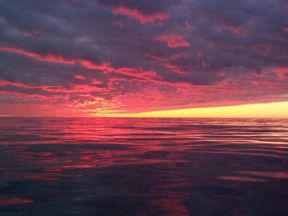
Next day (16 June), again a beautiful day, but that evening Herb, the weatherman gave us a warning about a forthcoming storm and asked us to go more easterly. The storm warning remained the next day, as was confirmed by Greenland coast guard. Herb asked for a more easterly coarse, but Cape Farewell and the ice was close enough and we chose to take whatever beating that was coming.
17 June, its getting colder and overcast, and it was time to reef the main, we kept one jib poled out to SB and one old jib flying to port. Wind increased more and more and soon we on reef 2, doing 8-9 knots. The seas are increasing but not alarming. In the afternoon we're down to reef 3, everything tied down tight and we're really moving, doing 8-10 and surfing ( a Colin Archer is not suppose to surf, I think) up to 15 knots, man, a lot of fun. Seas are no 15-20 feet and wind 45-50 knots. Its getting nasty and we take the radar down below and move down below ourselves and close the hatch. TOR is all alone out there and doing a great job, until 8 ours later, one of the steering lines brake. A lot of noise follows and Ulf and Arnie have to go on deck. The halyard has loosened and the SB jib is rattling like crazy. As we approach crawling forward on deck, the other jib explodes and are gone in 1/100 sec !!
We hove to by the main alone, which works great on a boat like Vilde, and Arnie tries two unsuccessful attempt to get the two halyards down, but no such luck.
After 6-8 hour of heaving to, the wind has decreased to 40 knots and we take the main down and starts to bare poling, sailing with no sails up, only the mast. We're doing 3.5 kn. and with 1200 rpm engine we do 5.5. TOR is reactivated and we can again go down below and enjoy peace, warmth and quite.
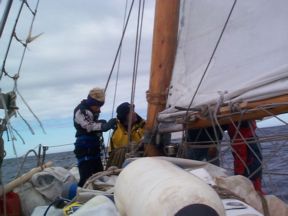
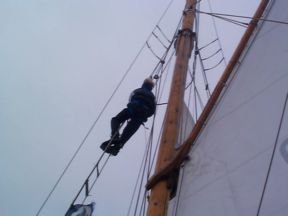
Next day, Arnie gets hold of the halyard and we are again under canvass, doing 5-6 kn. on
a beat due to a north-easterly. Herb´s on the radio and tells us to tack and go 25 miles
west, that way crossing a ridge and get a SW wind. Is he a magician ??? Well, we tacked
and after 5 hours we got the SW, which took us all the way to Greenland.
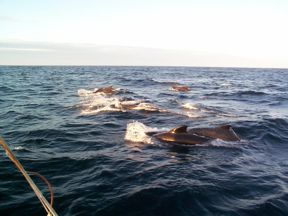
A new school of pilot whales, which seemed to be a family with small "calves" as
well as grown scary bulls. Again we enjoyed their yak- yak talk.
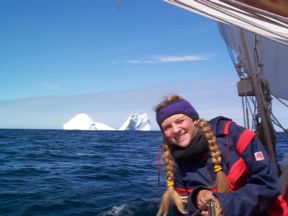
We approached Greenland surrounded by lots of icebergs and followed a beautifully
sheltered coastline, and tied up in Nuuk at 0600 in the morning June 21. After a few hours
rest we started to work on the boat, and repaired what the storm had damaged. The spray
hood needed repair as well as an spare sail needed to be modified in exchange for the one
we left in the Davis strait.
Mona made fresh bread, we got hold of fresh whale meat, yeah, we Norwegians are nuts, but better meat is actually hard to get, and it protects you against both colorectal cancer as well as coronary heart diseases in contrast to beef!!! And the taste is very similar.
This was Greenland's national day and everybody was out partying, and to our great and pleasant surprise we only saw one drunk Inuit. (Try Oslo May 17!)
We left Nuuk the 23rd early in the morning and headed north. We had a long way to go, more than 6 degrees latitude, and since there was no wind, we took the outside route since its faster. All along the coast there are high alpine like mountains covered with snow. We went inside through the narrows of the Hamborg island and here we saw waste amounts of whales. Ulf thought for a few minutes that we were headed for an unmarked reef, which turned out to be a humpback whale and her calf. Later on we saw several others, and one that was jumping out of the water.
We dropped the anchor in a small bay at ten o’clock and celebrated midsummer night with barbecued whale meat and red wine surrounded by snow-covered mountains and glaciers beautifully draped in the yellowish light from the midnight sun.

We're on our way to Disco bay, the coastline changes character from tall mountains to more mellow type terrain, deed fjords and millions of islands and skerries. No wind, so we take the outside route for the next 24 hours before we enter the inside route next morning. We're now in sheltered waters traversed by many fjords. Many of them being ice fjords, i.e. there's a glacier in the bottom. The Inuit name for such fjords are "sermilik" , meaning were the glacier ends. We now have lots of beautiful ice bergs around us, but without any navigational troubles. In this area we also meet local people living in small settlements always far out toward the coast. The houses are painted in red, blue green and yellow and looks like small flower bouquets. They are very friendly and greet us as we pass them.
We anchored that evening in a small bay just 1/2 hour south of Egedesminde, and Ulf makes a marinated leg of lamb for dinner. A small islet a few hundred feet away is "inhabited" by dogs, placed there by the inuits for the summer time. They can also smell the leg of lamb and are howling for food. They are deliberately only fed once a week. If fed more often they will suffer from the heat and might even die. Next day we go to Egedesminde, which is located on the south bank of Disco bay (70 N) for provisions, fuel and shower, before we set out for Godhavn on the Disco island. The weather is fantastic and we are surrounded by gigantic icebergs. It is from the Disco bay the iceberg that sank the Titanic came from, and the production of ice in Disco is so huge that 25% of the ice coming out of the Davis strait originates here. In the summertime there is a stationary high pressure over Disco bay that we now is taking advantages of.
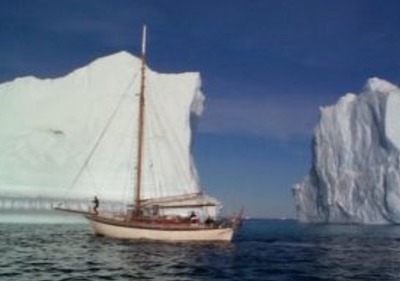
We're are in the land of the midnight sun and the
day has 24 hours and the time has no meaning, therefore one day
(night??) we had dinner at 0200 in the morning and breakfast at noon. We're really
enjoying the scenery which is really unbelievable. The icebergs are slowly passing while
"communicating" with us, The are continuously cracking and calving, millions of
trapped small air bubbles inside are breaking
making a crackling sound like soda water poured into a glass, and rivers and waterfalls
are coming of the side. All of this blended together with the sounds of blowing whales on
all sides, is definitely enough to make you reflect about how fantastic this planet really
is but also so vulnerable. We dropped the
anchor late that night in a small lagoon by some old Inuit dwellings.
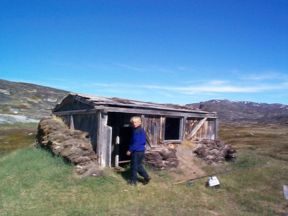
The dwelling contained also and old grave
yard with 9 graves, four adults and five children. We hiked into a river for some fishing,
but we had also put out the net, which turned out to be smart. The total catch was three
cods in the net.
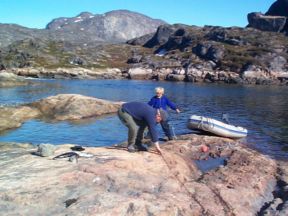

The bay also harbored millions of small herring like fish, that after spawning
collectively committed suicide by swimming ashore.
Later that day we left this secure haven bound for Jacobshavn, a small settlement on the east bank of Disco bay.
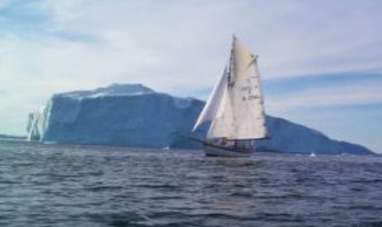
Hurrah, we have wind and the old Mr. "Diesel" can have a rest. This is a major
problem in the Arctic summer, there is
generally very little wind, but now we can enjoy complete silence and all the sounds from
the ice. As we approach Jacobshavn, we have to pass through miles and miles of fairly
dense ice, but no problem for us since we have copper shields on the outside of the hull.
Arnie is standing up in the mast giving steering directions to Ulf, and for a while we
feel really like Arctic pioneers.
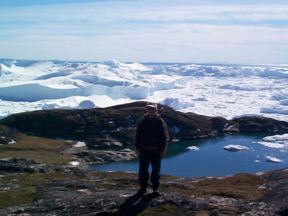
This glacier is the most active one on the northern hemisphere, migrating more than
50 m/day and producing more than 20 mill. tons pr. day, more water than needed for the
whole city of New York!
The temp, that day was 25 degrees Celsius (75 F).
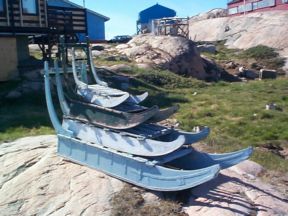

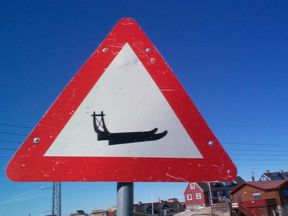
Jacobshavn was primarily inhabited by inuits and we saw only one snow scooter there, but a
lot of dog sledges, in all sizes, indicating that the children are taught the art of
dog-sledding quite early.
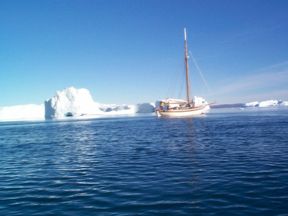
We left Jacobshavn next day, passing slowly in front of the mouth of the Jacobshavn ice
fjord, were the icebergs are finally sea born after being broken of the glacier more than
25 km (27 miles) inland. Suddenly we're approaching some unmarked reefs which this time
turns out to be a school of seals playing in the ice filled waters.
Approaching Egedesminde we were surprised by heavy fog banks, but fortunately we have the radar and have no navigational problems.
After "shit, showers and shave" , fuel and gas we're ready for a 24 hr stretch south towards Holsteinsborg . As we approach the settlement the engine overheated due to a broken fan belt, but fortunately, there was no wind and we could just drift slowly toward the jetty while putting in a new one (the third one this trip).
In Holsteinsborg, we met a Canadian sailboat that knew the weatherman Herb quite well, and they told us an amusing story about him being invited to the Naval Academy in Annapolis to teach the cadets meteorology. Herb refused because he felt a strong responsibility for all his friends out sailing waiting for his radio broadcast in the afternoon. However, the navy said; we also have radios (!!!) and the end of the story was that Herb went to Annapolis teaching meteorology in the morning and helping his friends, the blue-water sailors in the afternoon.
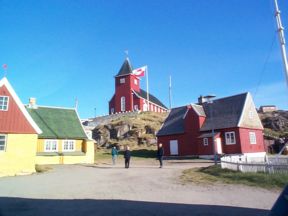
Holsteinsborg was a charming little community, the most northerly ice free port in
Greenland, but we didn't have time for a long stay and next morning we're on our way ,
this time we followed the beautiful inside route. Late in the evening we found that due to
low tide (3,5 m = 10 feet) a narrow passage was dry, so we had to wait for high water. No
big deal, and we enjoyed one of the most fantastic night along the west coast, and didn't
hit the sac until after sunrise approx. 0130.
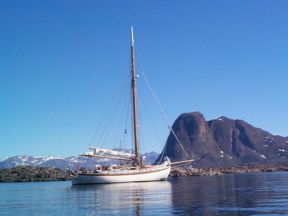
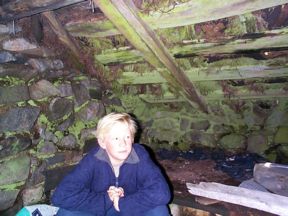
We anchored next to a small island with an old Eskimo dwelling that we
inspected before breakfast the next morning. Typically they're located as far out towards
the ocean as possible so that seals and whales could easily be observed and hunted. These
houses are so well insulated and heated only by burning blubber, that in the old days, the
inhabitants would sit almost naked inside.
We saw lots of migrating whales the following 24 hours. The humpback, easily recognized by their white sided tail and the Greenland whales, previously hunted close to instinct ions and recognized by their perfectly heart-shaped tail were close to the boat all the time blowing 3-4 times before they're gone for 5-6 minutes. There were a lot more icebergs in this area now, than 10 days ago. These are coming from the glaciers in southern Greenland and from the east coast and are far smaller than the ones in Disco, but have more interesting shapes.
Back in Nuuk, we were joined by an old friend Lars Moxheim from Norway. We did last minute shopping (more whale meat) fuel and fresh water before we left for the old Norse settlement called the western settlement. This area was abandoned approx. 1383 AD for unknown reason. We anchored in the evening outside the farm called Sandnes, which used to belong to Torstein Eiriksson, Leif´s (you know who) brother. He was married to the beautiful Gudrid, but Torstein died shortly after. She later married an Icelander, named Torfinn Karlsevne. Later he brought Gudrid with him to Vinland and that winter she there gave birth to a boy named Snorri, the first Norwegian -American (Euro -American) citizen.
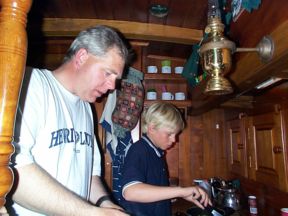
Ulf`s preparing dinner and caramel pudding for dessert and Andreas is a
keen learner.
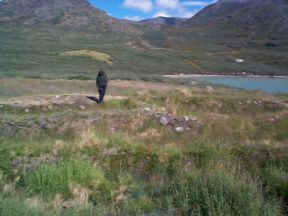
Andreas takes a morning swim (temp 13 Celsius,
55 F) before we go ashore and study the remains of the farm Sandnes. The buildings had
impressive dimensions, more than 90 feet x 30 feet. In
the stable, we could still see the flat stones standing vertically as dividers between the
animals.
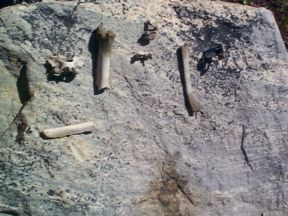
Somehow the land has sunk 5-6 meters (15-20 feet) in these areas and the church ruins are under water, but part of the church yard is still above the water. We found human remains (bones) sticking out of the ground.
The western settlement once contained more than 90 farms and 4 churches, and must have kept a close contact with the continent since it has been found arrowheads of Indian origin in the ground.
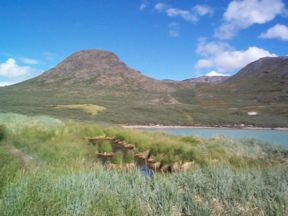
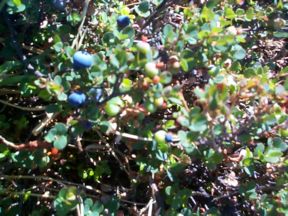
It was incredibly beautiful around Sandnes, tall green grass all over and lots of flowers. It turns out that the farm is located in the middle of a reindeer trial and we saw them all the time, sometime closer than 20 meters. Lars, Andreas and Arnies goes further into the valley named Austmanna valley to look for Fridtjof Nansen´s campground, where he camped after crossing the Greenland glacier in 1888. After about 12 km (8miles) we find the kidney shaped lake were he and Otto Sverdrup built their simple boat and rowed it out the fjord toward civilization. We also found a well preserved dwelling which also contained a stone store house, in addition to the sod house. We could still see the layers in the wall of the sod house still after 1000 years.
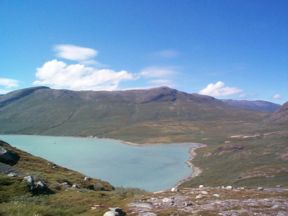
At low tide large areas in the bottom of the fjord
dried out. We hoisted the anchor at high tide in the afternoon and left for a promising
river with an Inuit name the means salmon river. We put out the net across river mouth
late that night and caught 3 salmons and 2 Arctic chars--yummy
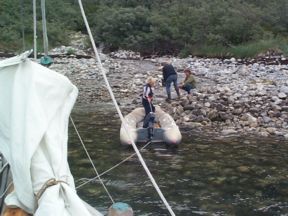
Smoked Arctic char for breakfast and salmon for dinner. We also needed fresh water and put
Vilde carefully aground outside a small creek and ferried 60 gallons of water onboard
before we finally left the Ameralik fjord on a gray foggy day. Later, as we approached the
coast, the weather improved and Lars got to see icebergs as well.
After 36 hours we came to Fredrikshåp and had a short visit ashore looking at an old (150) stave-like church before hitting the sac.
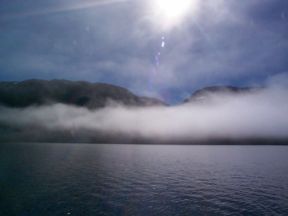
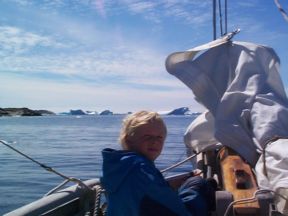
For the first time we experienced the famous Arctic fog and we moved slowly under the guidance of the radar, sneaking inside the ice belt normally covering the southern most tip of Greenland. The fog soon lifted and we could enjoy a beautiful scenery sig-sagging in-between drifting ice and icebergs.
Anchored in Kajaktorliq. Next day the wind was picking up and we had to leave in a hurry, the wind increased to more than 40-50 knots (storm) but from the east so the sea was flat. Later that day we also got heavy rain and fog, and experienced the only really miserable day in Greenland. There were a lot of ice, and close to Julianehåp, in Narsaq sound, we found the way blocked completely by icebergs and screw ice. We had to find another way around, but that would mean an unmarked and unmapped route. At slow speed we did find a new route without any troubles and without grounding.
In Julianehåp we met another Norwegian boat on its way home after three years in the Caribbean, and convinced them to go with us to Brattalid, “Erik the red’s” old farm.
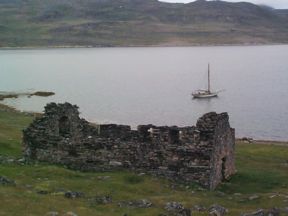
This is Whalsey church, the most complete of the
remains of the Norse settlements in Greenland. Here the last documented marriage was in
1408 between Sigrid Bjørnsdatter (daughter of Bjørn) and Torstein Olavsson (son of Olav)
and in the Saga, it´s written that they moved back to Iceland shortly after founding one
of the most influential family dynasties for generations.
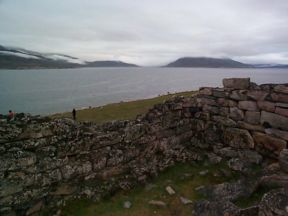
The feast-hall used for weddings and other important gatherings discussing the ever returning issue; "When is the boat from Norway coming?"
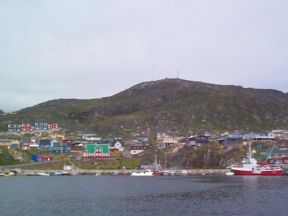
Back in Julianehåp to refill water and fuel before entering Eiriks fjord toward Erik the red farm, Brattalid.
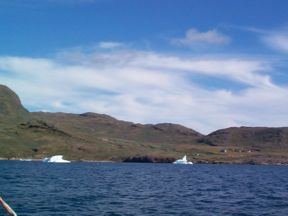
After a beautiful day we drop the anchor in a
small bay together with some inuits. Next day we will cross the hill along the "Kings
road" leading to Gardar, were the Norse Arch-bishop had his farm, together with a
monastery and naturally the Cathedral. Today the Inuit name for Gardar is Igaliko, meaning
the" abandoned cooking sites". Unfortunately, they have slaughtered the old
buildings making their own houses, and there was not so much to see.
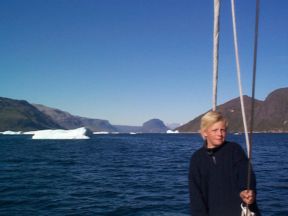
We leave for Brattalid, only a few hours away. There they are going to celebrate that it is 1000 years since Christianity came to Greenland, and the Danish royal family and many other guests are expected.
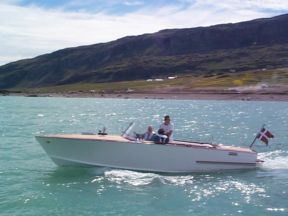
After dropping the hook next to our Norwegian friends we were visited by the Danish prince in his speedboat.

Brattalid is were “Erik the red” settled in 985-6 after being forced away from Iceland due to a murder he had committed. 25 boats left together with him from Iceland but only 14 made it across to Greenland. The house was a typical "long- house" common in Norway at that time. Later a church was build in front of the house were old headstones are seen today. Eric never converted, but his wife did, and she refused to sleep with him until he converted as well!…but he never did.
The immigration increased gradually, and the three settlements contained approx. 6000 people, on 278 farms. There are found more than 17 churches and 2 monasteries, and this community existed for almost 500 years. In comparison, that is longer than the America we know have existed, so far.
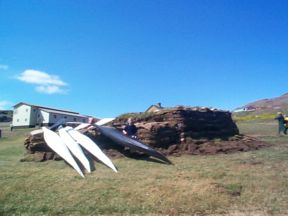
They have reconstructed an old sod house, a small chapel and a typical Inuit house .
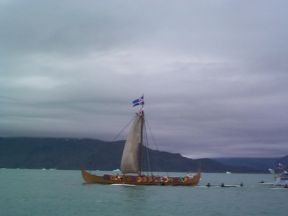
Next day a Viking ship arrived from Iceland, and
are met by inuits. They are demonstrating
their excellent techniques in their kayaks.
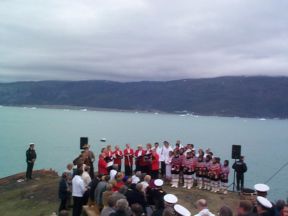
The official celebration, with a lot of high ranking officials, like the ambassadors from both the US and Canada, a big group of Norwegian-Americans from Seattle and the president of Iceland among others. We had expected the Norwegian King and Queen, but, sorry to say, they did now show up.
The Norwegian-American group from Seattle donated the statue of Leif Eriksson, and the American Ambassador took care of our interests in his excellent speech. He told a story from when Columbus was going to toast the first Indian chief, saying prost, and the chief answered him "SKÅL ".
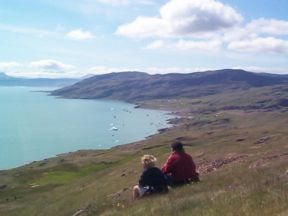
Mona and Arnie hiking the hills around Brattalid.


One hour from Brattalid is a fjord with a glacier in the bottom that had to be visited.
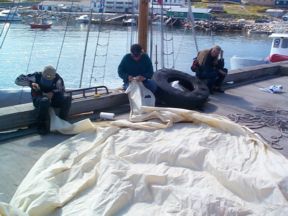
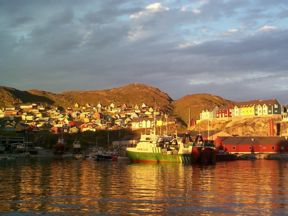
Fuelling up for the next Atlantic crossing, tomorrow is an excellent three day forecast, meaning we could be around the dreadful Cap Farewell (sic) before the next low pressure. In addition the ice conditions are very favorable, saving us several days of backtracking before we can be out in ice free waters.
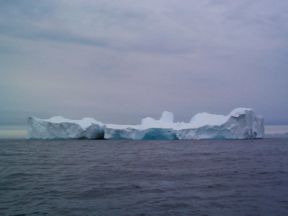
For the first four days we had no wind and had to depend on Mr. Diesel on low RPM to save fuel. We only do around 4.8 kn. Then, at day fifth day we get wind. It later increased to a full gale. Now we're moving, but its on the nose, making it a little uncomfortable. The water temp is steadily increasing from 35-36F to 60+F as we approach the gulf stream.
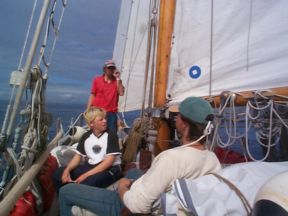
Thanks to the gulf stream we can "shower" on deck.
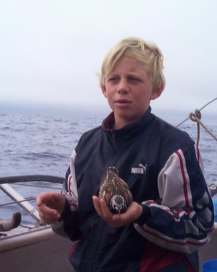
A very tame sea-svallow brightened our life for several hours one day, but left when we started the engine.
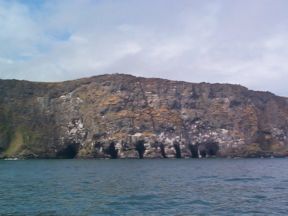
Finally we're in Ireland were we're going to meet friend from a boat named Karma. But going along the coast with 5 kn. current with us and force 6 against made this a very uncomfy´ day. 2 miles before we came to Ardglass, the engine stopped and we had to sail. It was still light, but getting dark fast and our charts wasn’t too good. Someone had called the Coast guard reporting a boat in trouble so they contacted us on the VHF. We were a bit close to shore by the time we got the sails up, we were not in trouble. However, they insisted on sending the rescue boat to take us safely in to the port, and we were so happy they did. It was a very tricky port, and we would not have made it to the yacht club doc without their help. On the local pub in Ardglass they followed the rescue operation on the VHF, so as we entered the dock, more than half the people on the pub were there to meet us in addition to our friend Tom from Karma! What a great welcoming committee! The next day before leaving for Strangforth loch we were visited by one of the crews that had brought his wife and son to meet us. Wonderful people these Irish!
A man came to look at the engine the next morning. He wanted to listen to the sound of it…. and it started! Arnie had bled and aired the engine after it stopped. And we tried to start it twice before giving up, so the conclusion was that it must have been air due to the heavy seas and little fuel left. If we had tried to start it a third time, we most likely would have succeeded- SHIT. We would also have missed a fabulous rescue operation! And they are for free in Northern Ireland!!
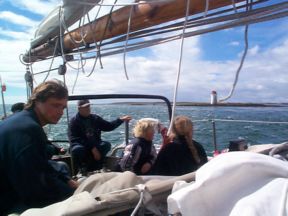
Tom came in the morning to pilot us up the tricky
sounds of Strangeford loch. Doing the tide right,
we were at times doing close to 14 kn. over ground.
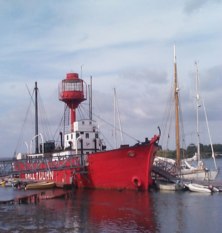
The Down cruising club has its own light ship that have been beautifully converted to a yacht club. Everybody had heard about our "disaster" in Ardglass and we felt so welcome. The Irish are incredibly friendly and we just had to buy a membership into this wonderful charming club, and are now proudly flying their flag.
The next day Tom and his wife Loraine took us around to do laundry, ditto shopping and to pick up John at the airport.
We passed a charming little village named Lisbane. The village has 1000 inhab. and 11 pubs! They love their pubs!
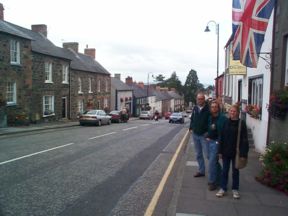
We rented a car for 3 days and drove around in the beautiful landscape of northern Ireland. Now we really learned to appreciate all the shades of green. This picture is taken in the village of Hillsborough.
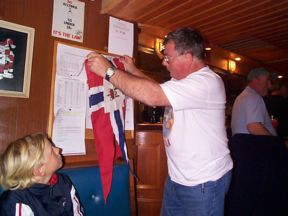
Jerry, who is the club commodore is given the flag
of the Royal Norwegian Yacht club.
We're impressed by the wealth we se in N-Ireland and everything is so neat and clean. The villages are decorated with flowers all around, no tagging on the walls, but the dark side of the story, as Loraine and Tom told us, there are hardly a family that has not been somehow strucked by the violence over the last 25 years.
Lene is finally around teenagers her own age and is very well taken care of. She is invited to spend the night at Lorain and Toms house together with their daughter Susan and her friend Alex.
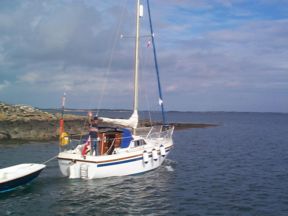
Lene and Andreas sailed with Tom and his family that Sunday, while Arnie, John and I was out sightseeing. Fortunately, Andreas took the boat out in the loch, because when we were leaving, the following day, he was the only one who knew the way out. The tide was perfectly timed, and we left the loch as fast as we entered. In Ireland,
everyone that owns a boat has a tide table in their pocket. You can not even enter or leave the yacht club if the tide is low.
The next 90 miles are sort of boring, with no wind and fog, but we are happy that we did not have to fight wind and strong tides again. At 11 am we finally drop the anchor at Gigha, a small island south east of Jura. From here we have a good starting point for the inside passage of the inner Hebrides.
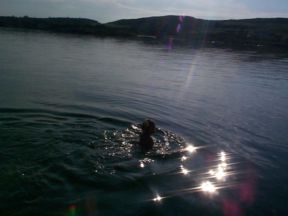
After breakfast, we went for a hike, while the kids rented 2 bikes. The pubs in the Hebrides are grate as well as their bitter, which had to be tested. The weather changed to the better, and the kids even went for a swim ?????
We had an early start at 0600 bound for Drambuie, heard that name before ?? It was a beautiful enclosed bay, but the weather was again gray and rainy, but a S-E breeze gave us nice sailing.
Next day started out cloudy but gradually changed
to the better, and we entered the beautiful little village of Plockton glittering in the
afternoon sun.
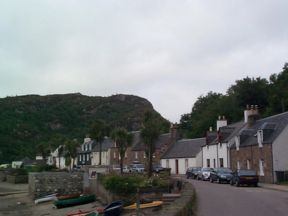
Plockton has 300 inhabitants and are located along
the shore in the bottom of a shallow bay. The waterfront is lined with palm trees !!??,
but this is still Scotland. On the other side of the bay is located an old castle, which
now was being converted into a youth-hostel! We have dinner on the local pub, and while we
have e few pints the kid play snooker. Next morning we passed the one inside of Skye under
power, and had a nice reach all the way to Stornoway on the outer Hebridies. As we entered
the harbor, we were met by big fat seals that would eat food directly from our hands.
Stornoway was a cozy little fishing town, and we had dinner in a small
restaurant called the Whalers dram. The owner used to sail on Norwegians whalers but now
made more money selling food and spirits to people. When we entered the bar, he said
"are you the Norwegians in the sailboat??? It turned he had been on the ferry that
passed us as we entered the harbor (no discount though). Next morning we visited the coast
guard to get information about the passage to and through the sound. There are so many
stories about the strait that we wouldn't take any chances. We studied the tide tables and
left at 1700 in beautiful sunshine.
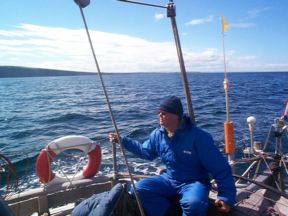
We had to motor sail the whole night due to lack of wind (what else is new), and since the passage was faster than anticipated, we had to go by the small town of Thorsu (Thor´s island??) and visited a pub for 5 hours until the current were favorable. Lunch and a few last Scottish pints of beer.....
When we finally went through the strait of Bell
Isle, we did so in 10-12 knots of speed over ground. Later that night, it became rather
foggy and we needed the radar to find our way in between the oil installations that are
spread out over the north sea. After three days, we came to Kristiansand in beautiful
sunshine. Later that night it was difficult to go to bed. We were back in Norway after
being away for 14 months and She showed herself of with beautiful moonlight. The next
morning, we started at 0600 at sun-rise and went the inter coastal route northbound.
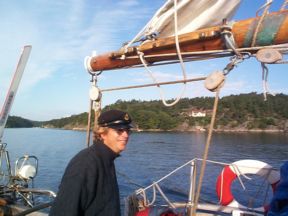
In the afternoon, the wind picked up and we set the sails and "Tor" could take
over. We didn’t anchor before late that night, only to more days to go.........
The last morning, no wind, but beautiful sunshine and we left the little fishing village Son at noontime. We were told that we were expected home at 1600 so we had to go slowly, it was only 22 miles to go. As we passed the Oscarborg fortress, the one that sunk the German cruiser "Blucher" we were met by good friends that came out in their yacht waving flags and blowing foghorns. Later more boats came joining in.
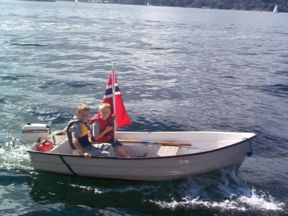
Andreas and Lene´s first cousins, Martin and Fredrik and
Mona´s sister Hjørdis, John´s son Audun in his little boat and everybody
wants to come onboard
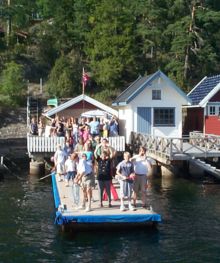
Here we are, back to stage one ,pretty much on the day 14 month after leaving. Everybody is here, family and close friends. First Champagne down at the dock, and later more champagne, white wine and shrimps at the patio of Arnies parent. We were close to 100 people all together!
At our house there was flowers inside and outside, food in the fridge, and champagne on the table! It was fantastic!
We were gone for 14 short months, but we have come back with so many fantastic experiences. We have seen so many new places, from tropical rain forests and coral reefs to glaciers and gigantic icebergs, but most importantly, we have experienced such a great warmth and hospitality among all the different people we have met, both on sea as well as on land, and we have made so many new friends. All of this has made this year very, very special to all four of us.
Arnie and I have had this trip on the planning board for more than 20 years, and as Andreas just said: “Now we will enjoy the memories for the next 80 years!” We might not live that long, but it is a measurement of the experiences this year has given us!
Thank you very much!!